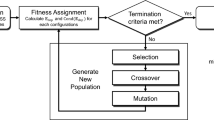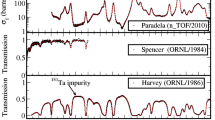Abstract
7Li(p,n)7Be reaction can be used for neutron generation for use in BNCT, but the lithium target must be protected from exposure to air, typically by being kept in vacuum. Keeping lithium target in vacuum and isolated conditions in all stages of construction and replacement in the system can be difficult and expensive. In this article we propose a method to prevent lithium’s reactivity with air using proper materials. The results show that use of polyimide, is a good choice for preventing lithium’s reactivity with air, and it is also a cost-effective choice. In addition, this choice has many benefits among them the reduction of fast neutron flux to 41% and it also establishes the IAEA-recommended in-air parameters. Dosimetric evaluation in the simulated head phantom shows that our designed beam is useful to treat deep seated brain tumors with the reduction of damage to the healthy tissue when treating deep-seated brain tumors. The dose in the first point in healthy tissue will decreases about 17%. All calculations were performed with the MCNPX code.








Similar content being viewed by others
References
Bosko A, Zhilchenkov D et al (2004) GE PET trace cyclotron as a neutron source for boron neutron capture therapy. Appl Radiat Isot 61:1057–1062
Soloway AH, Tjarks W et al (1998) The chemistry of neutron capture therapy. Chem Rev 98:1515–1562
Bleuel DL, Donahue RL et al (1998) Designing accelerator based epithermal neutron beams for boron neutron capture therapy. Med Phys 25:1725–1734
Sakamoto S, Kiger WS et al (1999) Sensitivity studies of beam directionality, beam size, and neutron spectrum for a fission converter-based epithermal neutron beam for boron neutron capture therapy. Med Phys 26:1979–1998
Lee CL, Zhou XL (1999) Thick target neutron yields for the 7Li(p,n)7Be reaction near threshold. Nucl Instrum Methods Phys Res Sect B 152:1–11
Montagnini B, Cerullo N et al (2002) Spectrum shaping of accelerator-based neutron beams for BNCT. Nucl Instrum Methods Phys Res Sect A 476:90–98
Tanaka K, Kobayashi T (2006) Characterization of moderator assembly dimension for accelerator boron neutron capture therapy of brain tumors using 7Li(p,n)7Be neutrons at proton energy of 2.5 MeV. Med Phys 33:1688–1694
Bengua G, Kobayashi T et al (2004) Optimization parameters for BDE in BNCT using near threshold 7Li(p,n)7Be direct neutrons. Appl Radiat Isot 61:1003–1008
Matysiak W, Prestwich WV et al (2012) Measurements of the neutron spectra from the 7Li(p,n) accelerator based neutron source: position and angular dependences. Radiat Phys Chem 81:1673–1682
Halfon S, Paul M et al (2011) High-power liquid-lithium target prototype for accelerator-based boron neutron capture therapy. Appl Radiat Isot 69:1654–1656
Randers-Pehrson G, Brenner DJ (1998) A practical target system for accelerator-based BNCT which may effectively double the dose rate. Med Phys 25:894–896
Bayanov B, Belov V et al (2009) A neutron producing target for BINP accelerator-based neutron source. Appl Radiat Isot 67:282–284
Kamada S, Takada M et al (2014) Development of target system for intense neutron source of p-Li reaction. Appl Radiat Isot 88:195–197
Bayanov B, Belov V et al (2006) Neutron producing target for accelerator based neutron capture therapy. J Phys Conf Ser 41:460–465
Kwon J, Kim J et al (2015) A novel synthesis method for an open-cell microsponge polyimide for heat insulation. Polymer 56:68–72
Kim H, Jang J (2000) Corrosion protection and adhesion promotion for polyimide/copper system using silane-modified polymeric materials. Polymer 41:6553–6561
Huang YC, Lo TY et al (2014) Anti-corrosion characteristics of polyimide/h-boron nitride composite films with different polymer configurations. Surf Coat Technol 260:113–117
Feng L, Iorh JO (2014) corrosion resistance and lifetime of polyimide-b-polyurea novel copolymer coatings. Prog Org Coat 77:590–599
Huang TC et al (2011) Electrochemical studies on aniline-pentamer-based electroactive polyimide coating: corrosion protection and electrochromic properties. Electrochim Acta 56:10151–10158
Bessonov MI, Koton MM et al (1987) Polyimides—thermally stable polymers. Plenum Publishing Corp, New York
Huttunen-Saarivirta E, Yudin VE et al (2011) Corrosion protection of galvanized steel by polyimide coatings: EIS and SEM investigations. Prog Org Coat 72:269–278
Pelowitz D (2008) MCNPX users manual, LA-CP-07-1473. Ver. 2.6.0. Los Alamos National Laboratory, Los Alamos
Alger MSM (1987) High temperature and fire resistant polymers. In: Blackie DRW (ed) Specialty polymers. Chapman and Hall, New York
Ramos MMD, Stoneham AM et al (1993) Aluminium/polyimide adhesion. Acta Metall Mater 41:2105–2111
Ramos M (2002) Theoretical study of metal–polyimide interfacial properties. Vacuum 64:255–260
Skeist I (ed) (1990) The handbook of adhesives. Nostrand Reinhold, New York. ISBN 0-442-28013-0
Vollmer B (1973) Polymer chemistry, Berlin, Heidelberg. New York
Wolfgang AG et al (2012) Neutron capture therapy. Springer, Heidelberg
Ahmadi Ganjeh Z, Masoudi SF (2014) Neutron beam optimization based on a 7Li(p;n)7Be reaction for treatment of deep-seated brain tumors by BNCT. Chin Phys C 38:108203(1-6)
Incropera FP, DeWitt PD (2002) Introduction to heat transfer, 4th edn. Wiley, New York
IAEA-TECDOC-1223 (2001) Current status of neutron capture therapy. International Atomic Energy Agency, Vienna
Auterinen I, Seren T et al (2004) Measurement of free beam neutron spectra at eight BNCT facilities world wide. Appl Radiat Isot 61:1021–1026
Cerullo N, Esposito J et al (2004) Spectrum shaping assessment of accelerator-based fusion neutron sources to be used in BNCT treatment. Nucl Instrum Methods Phys Res Sect B 213:641–645
Herrera MS, Gonzalez SJ et al (2013) Evaluation of performance of an accelerator-based BNCT facility for the treatment of different tumor targets. Phys Med 29:436–449
Snyder WS, Ford MR et al (1969) Estimates of absorbed fractions for monoenergetic photon sources uniformly distributed in various organs of heterogeneous phantom. J Nucl Med Suppl 3:7–52
Rasouli FS, Masoudi SF (2015) A study on the optimum fast neutron flux for Boron Neutron Capture Therapy of deep-seated tumors. Appl Radiat Isot 96:45–51
KigerIII WS, Sakamoto S, Harling OK (1999) Neutronic design of a fission converter based epithermal neutron beam for neutron capture therapy. Nucl Sci Eng 131:1–22
Torabi F, Masoudi SF, Rahmani F, Rasouli FS (2014) BSA optimization and dosimetric assessment for an electron linac based BNCT of deep-seated brain tumors. J Radioanal Nucl Chem 300:1167–1174
Author information
Authors and Affiliations
Corresponding author
Rights and permissions
About this article
Cite this article
Ahmadi Ganjeh, Z., Eslami-Kalantari, M. A study of the simulation of the influence on formed neutron spectrum when Li target was covered with polyimide protective film. J Radioanal Nucl Chem 318, 1025–1031 (2018). https://doi.org/10.1007/s10967-018-6161-1
Received:
Published:
Issue Date:
DOI: https://doi.org/10.1007/s10967-018-6161-1




